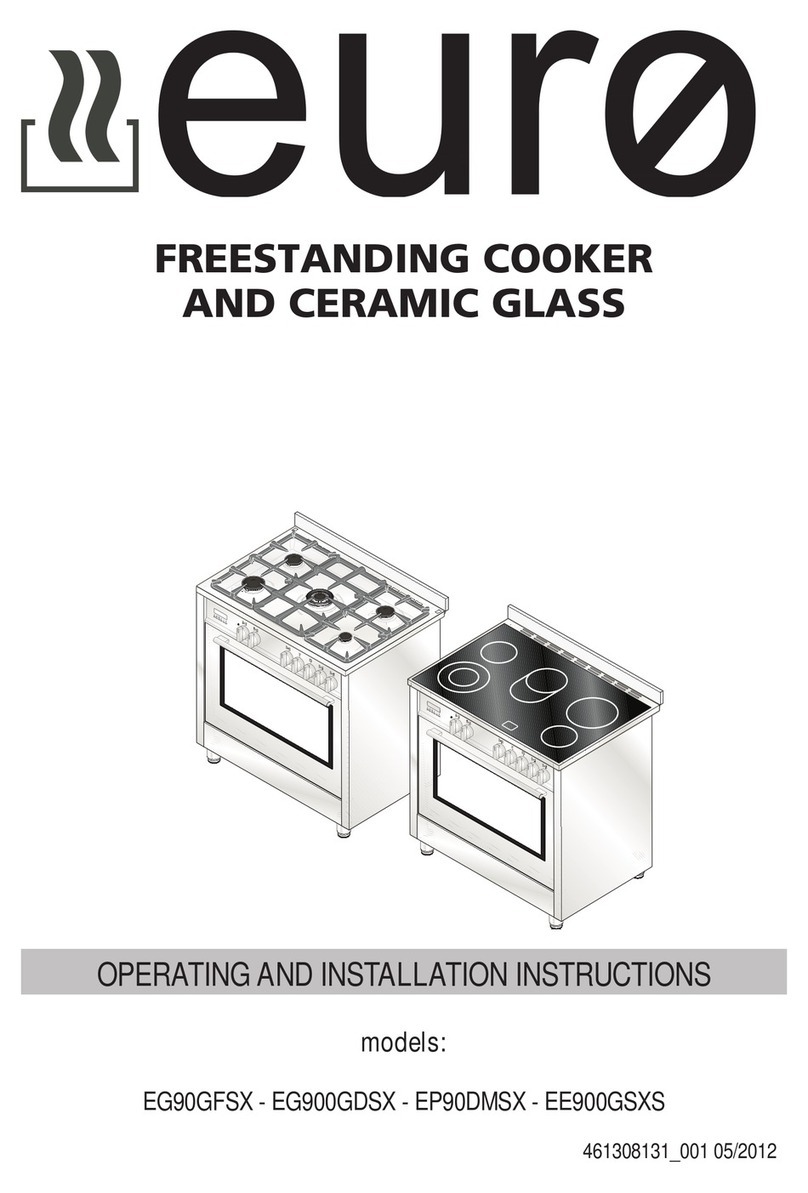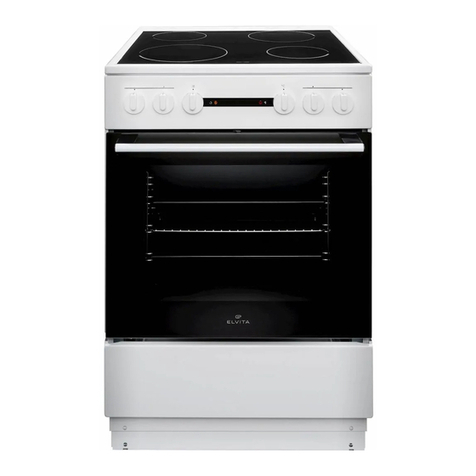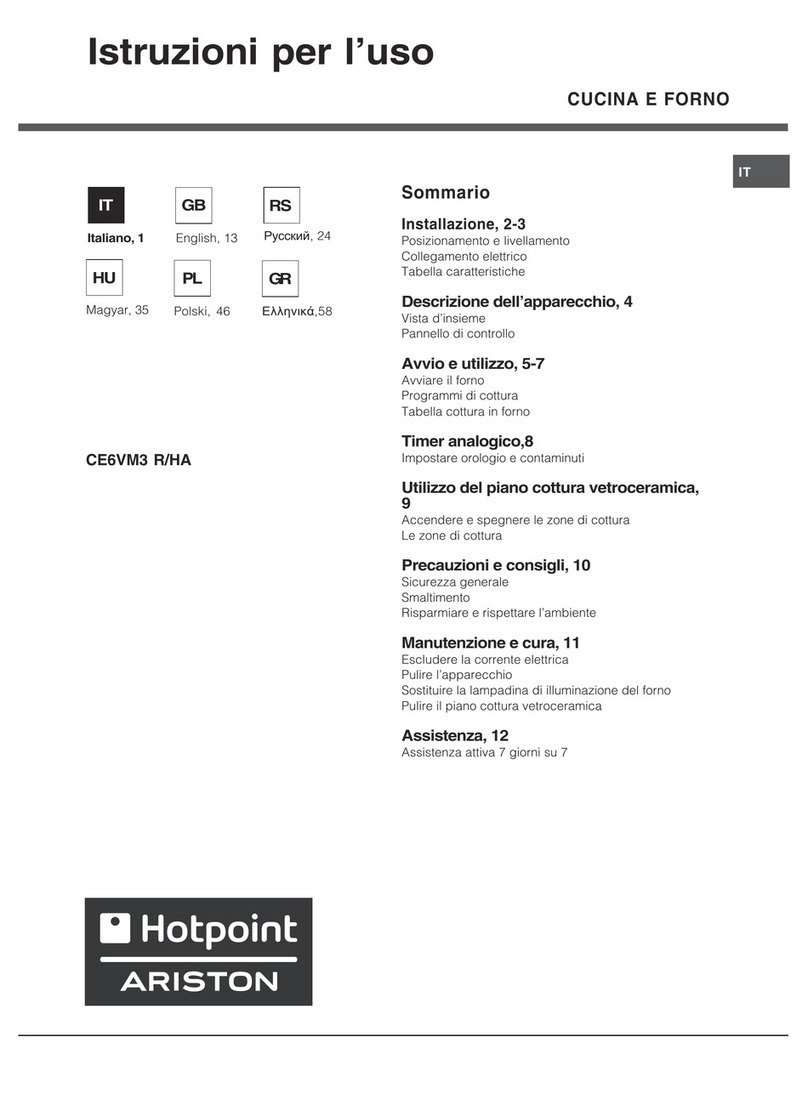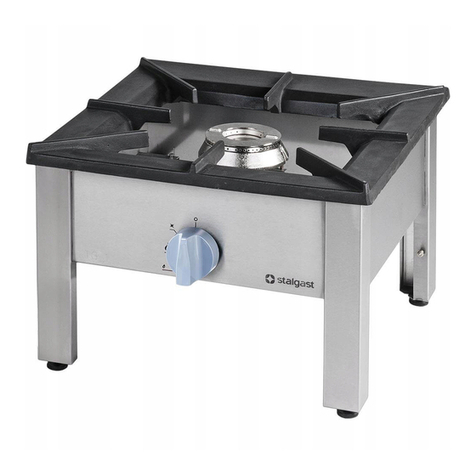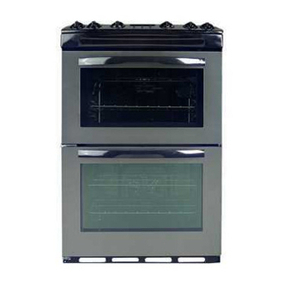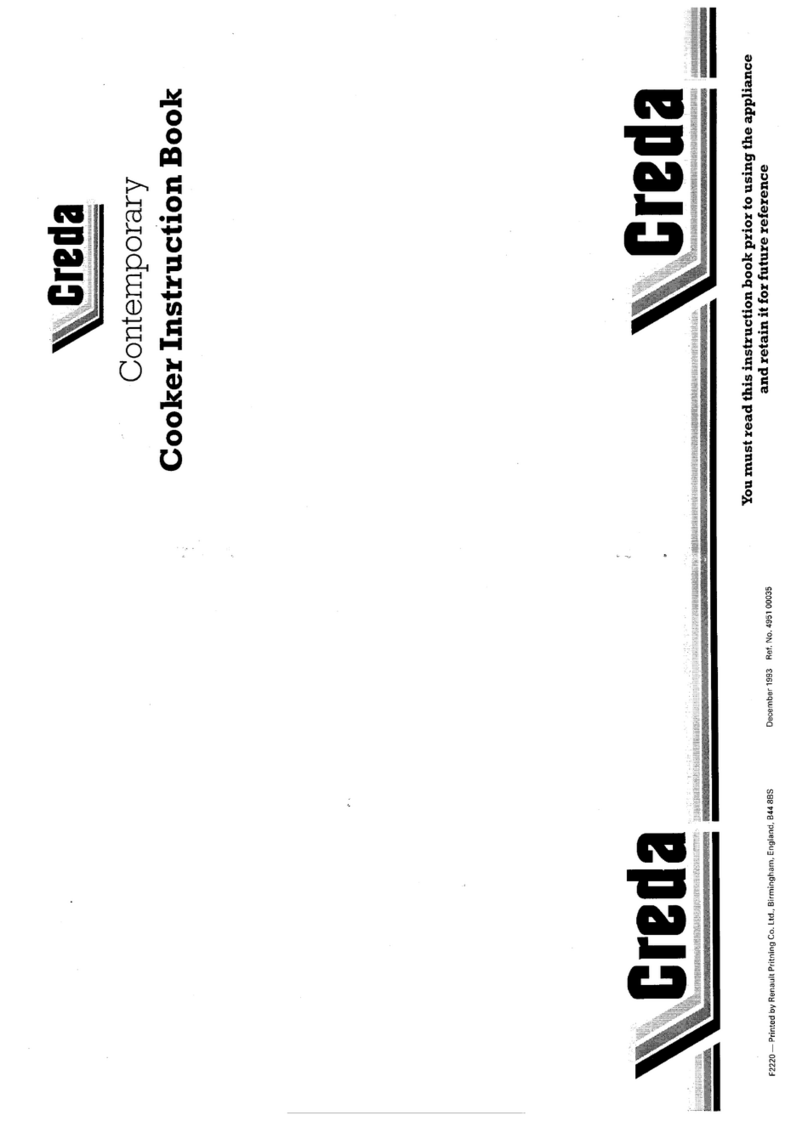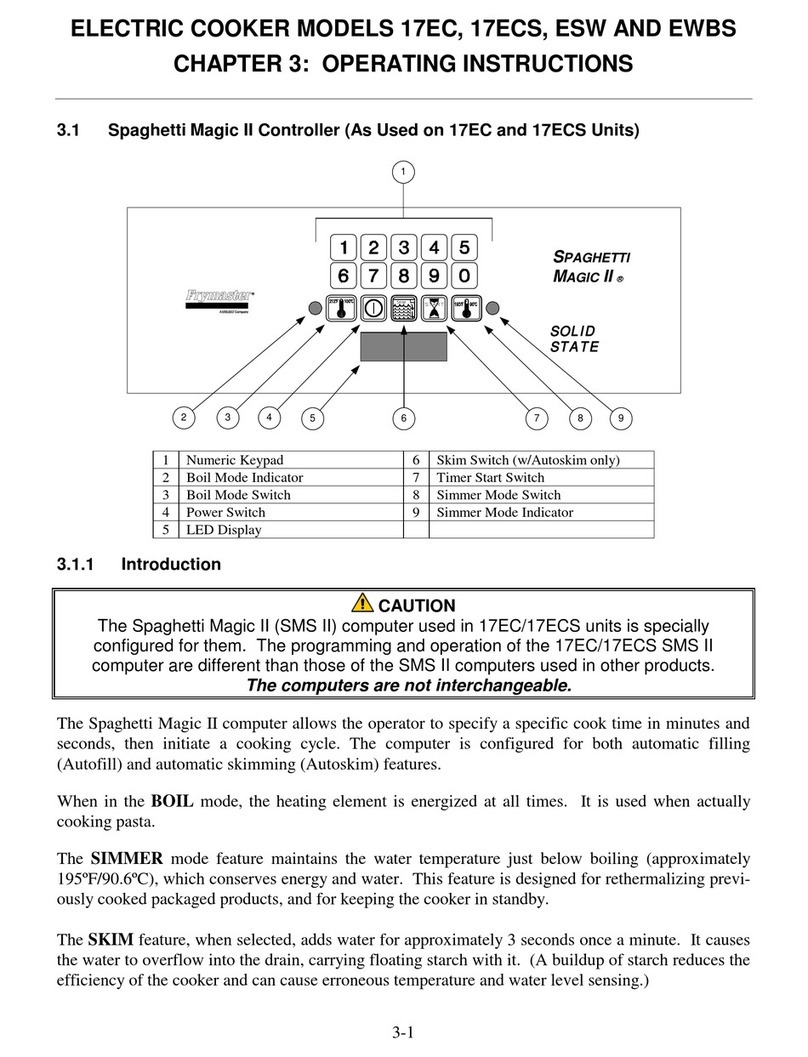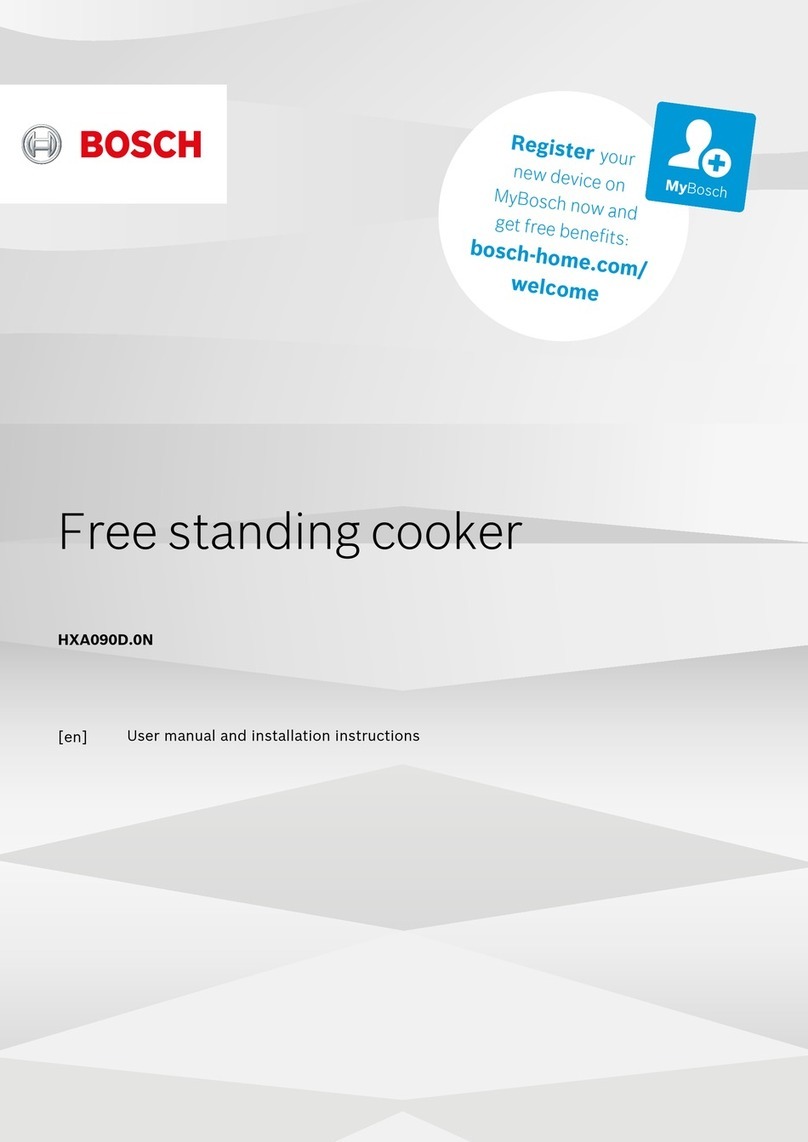EURO EG60FS Operating instructions

461308002 (RS-001) 05/2011
A GUIDE TO USE,
INSTALLATION AND REGULATION
OF YOUR COOKERS
Model: EG60FS
Model: EG600FS2X
aus
MANUFACTURED BY: TECNO spa

2
461308002 (RS-001) 05/2011
The appliance was designed and made in accordance with the European standards listed below:
=> EN 30-1-1, EN 30-2-1 and EN 437 plus subsequent amendments (gas)
=> EN 60 335-1 and EN 60 335-2-6 (electrical) plus relative amendments
The appliance complies with the prescriptions of the European Directives as below:
=> 2006/95 EC concerning electrical safety (BT).
=> 2004/108 EC concerning electromagnetic compatibility (EMC)
=> 2009/142/EC concerning gas safety.
Oven accessories that could come into contact with foodstuffs are made with materials that comply with
the provisions of the 89/109 EC directive dated 21/12/88.
This product complies with EU Directive 2002/96/EC.
The crossed-out dustbin symbol reported on the appliance indicates that the appliance must be disposed
of separately from other domestic refuse at the end of its useful life. It must therefore be delivered to a
waste recycling centre specically for electric and electronic equipment or returned to the retailer at the
moment of purchase of a new equivalent appliance.
The user is responsible for delivering the appliance to the appropriate collection centre at the end of its
useful life, Failure to do so may result in a ne, as provided for by laws governing waste disposal.
Differential collection of waste products for eventual recycling, treatment and environmentally friendly
disposal helps reduce possible negative effects on the environment and health, and also enables the
materials making up the product to be recycled.
For more detailed information on the available refuse collection systems, refer to the local Municipal
Solid Waste disposal centre or the shop where the product was purchased.
Producers and importers are responsible for fullling their obligations as regards recycling, treatment
and environmentally friendly disposal by directly or indirectly participating in the collection system.
CONTENTS
ASSISTANCE AND SPARE PART 3
IMPORTANT NOTES AND PRECAUTIONS FOR USE 4
DESCRIPTION OF THE APPLIANCE 5-7
INSTRUCTIONS FOR THE USER 8-14
TROUBLESHOOTING 15
INSTRUCTIONS FOR THE INSTALLER 16-22
TECHNICAL FEATURES 23

3
461308002 (RS-001) 05/2011
ASSISTANCE AND SPARE PARTS
Before this appliance left the factory it was tested and set by specialized, expert personnel in order to guarantee
the best functioning results.
Any subsequent repairs or adjustments that may be necessary must be done with the maximum of care and
attention by authorised personnel.
For this reason we recommend you always contact us (refer below), specifying the brand, model, serial number and
type of problem you are having with it. You will nd the relative data printed on a label afxed on the appliance and
on the label afxed to the packing box.
IMPORTANT NOTICE
The manufacturer shall not be held responsible for any damage to persons or property caused by incorrect
installation or use of the appliance.
For prompt warranty service, please ensure that the warranty registration form is completed and return posted
to us.
A duplicate data label and wiring diagram are contained in this booklet. Please attach these labels to an accessible
surface near by the appliance for easy reference.
You can purchase original spare parts from authorised dealers or direct from us.
DOMESTIC USE ONLY
SPACE FOR DATA LABEL

4
461308002 (RS-001) 05/2011
IMPORTANT NOTES AND PRECAUTIONS FOR USE
You have purchased one of our products for which we
thank you. We are condent that this new appliance,
modern, functional and practical, made with top quality
materials, will meet all your demands. This new appliance
is easy to use but before installing and using it, it is
important to read this handbook through carefully.
It provides information for a safe installation, use and
maintenance. Keep this handbook in a safe place for
future reference.
The manufacturer reserves the right to make all the
modications to its products that it deems necessary
or useful, also in your interests, without prejudicing
its essential functional and safety characteristics.
The manufacturer cannot be held responsible for any
inaccuracies due to printing or transcription errors that
may be found in this handbook.
N.B.: the pictures shown in the gures in this handbook
are purely indicative.
• The installation, adjustments, conversions
and maintenance operations listed in section
«INSTRUCTIONS FOR THE INSTALLER» must only
be carried out by authorised personnel .
• The installation of all-gas and combi appliances must
comply with the standards in force.
• The appliance must only be used for its original
purpose, that is, cooking for domestic use. Any other
use is considered improper and, as such, dangerous.
• The manufacturer cannot be held responsible for
any damage to persons or property resulting from
an incorrect installation, maintenance or use of the
appliance.
• Once the packaging has been removed from the outer
surfaces and the various inner parts, thoroughly check
that the appliance is in perfect condition. If you have
any doubts do not use the appliance and call in an
authorised person.
• The packaging materials used (cardboard, plastic
bags, polystyrene foam, nails, etc.) must not be left
within easy reach of children because they are a
potential hazard source. All packaging materials used
are environmentally-friendly and recyclable.
• The electrical safety of this appliance is only guaranteed
if it is correctly connected to a suitable earth system,
as prescribed by the electrical safety standards. The
manufacturer disclaims all responsibility if these
instructions are not followed. Should you have any
doubts, seek the assistance of an authorised person.
• Before connecting the appliance ensure that the rating
plate data corresponds to that of the gas and electricity
supply (see section «TECHNICAL FEATURES»).
• Do not install this appliance on a marine craft or in a
caravan.
There are a few basic rules that must be observed
when using the appliance:
=> Do not use this appliance as a space heater.
=> Do not touch any electrical appliance if hands or feet
are wet or damp.
=> Do not use the appliance bare footed.
=> Do not pull the power lead to take the plug out of the
socket.
=> Do not leave the appliance outside under the sun,
rain, etc.
=> This appliance is not intended for use by persons
(including children) with reduced physical, sensory
or mental capabilities, or lack of experience and
knowledge, unless they have been given supervision
or instruction concerning use of the appliance by a
person responsible for their safety
=> Young children should be supervised to ensure that
they not play with the appliance.
• WARNING - ln order to prevent accidental tipping of
the appliance, for example by a child climbing onto
the open oven door, the stabilizing means must be
installed. Please refer to instructions for installation..
• Before cooking for the rst time, ensure the oven
is empty and its door closed, heat the oven at
maximum temperature for two hours. This will allow
the protective coating on the interior of the oven to be
burnt off and dissipate the associated smells. Ensure
adequate ventilation in the kitchen whilst burning off
and don’t be alarmed by a little bit of smoke during this
process.
• WARNING - Accessible parts will become hot when
in use. To avoid burns and scalds children should be
kept away
• Keep the appliance clean. Food deposits could be a
re risk.
• Avoid using the oven as a larder or as a saucepan
cupboard when you are not using it for cooking: if the
oven is turned on accidentally it could cause damage
and accidents.
• If you are using an electrical socket near the appliance,
make sure that the cables are not touching the cooker
and are far enough away from all hot parts.
• When you have nished using the appliance check
that all the controls are in the off or closed position,
checking that the “0” of the knob corresponds to the
“•” symbol serigraphed on the front panel.
• Switch off the electrical supply before you start
cleaning or servicing the appliance.
• In the case of a failure or malfunction, turn the
appliance off and switch off the electrical supply and
do not tamper with it. All repairs or adjustments must
be carried out with maximum care and the proper
attention of an authorised person.
For this reason we recommend you call our Service
Centre.

5
461308002 (RS-001) 05/2011
1
2
1
PRESENTATION
Our cooker is tted with a fully gas hotplate.
This innovative burner hotplate offers you more scope
and versatility in hotplate cooking than ever before. The
round burners are graduated in their size and output
to provide the exact heat required for every style of
cooking. Each knob on the front panel has a diagram
printed above it showing to which burner it refers.
Our cooker is tted with a fully gas oven (gas and grill
burner).
To guarantee the customer a good and safe use of the
appliance, the cookers have equipped with a safety
temperature device, which automatically turns on in
case the main thermostat fails to work. In such an
event, the electricity is interrupted temporarily: do not
attempt to repair it yourself but turn the appliance
off and contact your nearest Assistance Centre.
The oven walls are tted with various runners (g. 1)
on which the following accessories can be placed (g.
2):
• oven shelf rack (Gf). Ensure shelf is located with
dish and tray stop pointing upwards and at rear of
oven.
• drip tray (V)
• handle (D)
• drip tray grid (E)
The cookers are tted with a warming drawer (not
completely extractable) that can be used for storing
things.
Remember that the surfaces become hot, it is
strictly forbidden to place inammable materials
inside.
DESCRIPTION OF THE APPLIANCE

6
461308002 (RS-001) 05/2011
aB
D
TIMER (C)
To set cooking time, rst
wind the timer up by
turning it completely once
from left to right and then
back to the number of
minutes you want. The
timer will ring when the
set time has elapsed.
C
CONTROLS
HOB GAS BURNER KNOB (A)
By rotating the knob in an anticlockwise direction, the
following symbols appear:
0= Closed position
= “Full on” position
= “Reduced rate or Low” position
GAS OVEN/GRILL THERMOSTAT KNOB (B)
By rotating the knob in an anticlockwise direction, the
following functions appear:
0= Closed position
from Min. to Maxi (260°C) = Oven temperatures
Turn the knob clockwise if you want to use the gas
grill .
OVEN LIGHT SWITCH
OVEN FAN SWITCH
DESCRIPTION OF THE APPLIANCE
ELECTRONIC CLOCK (D)
This accessory functions as a clock and a minute
counter. The digital display always shows the time but
will display the minute counter time when this function
is set.
Setting the time (from 0.01 to 24.00 - hh,mm)
After connecting to the electricity mains or subsequent
to a power cut the gures “0.00” will ash on the display.
Press push button 1 and start setting the current time
by pressing push button 2 or 3. The function will start 7
seconds after setting.
Minute counter (from 0.01 to 0.99 = hh,mm)
By selecting the time on the minute counter with push
button 3, this function will be active all of the time (time is
set in 10 second units). The time will disappear leaving
the minute counter time showing on the display and the
symbol lights up. Time is given in seconds during
countdown. At the end of the set time the buzzer goes
off, the symbol disappears and the time reappears.
You can see the time while the minute counter is
functioning by pressing push button 1.
Buzzer
The buzzer goes off at the end of the minute counter
function and lasts about 7 minutes. The buzzer can be
stopped by pressing button 3.
Buzzer intensity
There are three different buzzer intensities: to select
the one you want press push button 2 when the time
is displayed.
Correcting/cancelling the minute counter function
To correct or cancel the time set on the minute counter,
press keys 2 and 3 simultaneously and then release
key 3 rst. The time can be corrected at any moment
by pressing push button 1 followed by 2 or 3.

7
461308002 (RS-001) 05/2011
3
54
6 7
HOB: GENERAL NOTES ON SAFETY
• When using the burners, do not leave the appliance
unsupervised. Ensure that children and the inrm
do not play with the appliance. In particular, make
sure that pan handles are positioned correctly and
supervise the cooking of foods which use oils and
fats, as these are highly inammable.
• Do not use aerosols or sprays near the appliance
when it is in use.
• Even after use, the burners remain hot for a long
period; to avoid burning, do not place hands or
other objects on them.
• After using the appliance, ensure that all the controls
are in the closed or off position.
AUTOMATIC ELECTRIC IGNITION OF COOKTOP
BURNERS
Push lightly the knob (A) which corresponds to burner
to be ignited and turn anti clockwise to the “Full On”
position, then depress the control knob.
Automatically the ignition spark shoots. If there is no
electric power the burner may be lit with matches.
OPTIMUM USE OF COOKTOP BURNERS
In order to achieve maximum efciency with minimum
gas consumption it is useful to remember:
• Do not use large burners with pans of small diameter
in order to avoid ames spreading wider than pans
(consult the following table) and always use pans
with lids (g. 3).
• When the boiling point is reached, it is best to turn
the knob to the “Low position”.
• Avoid using over sized pans that may radiate
excessive heat and cause damage to surrounding
surfaces such as bench tops and glass lid.
• Do not place anything, e.g. ame tamer, asbestos
mat, between pan and pan support, as serious
damage to the appliance may result (g. 4).
• Locate pan centrally over the burner so that is stable
and does not overhang the appliance (g. 5).
• If gas burns with a yellow ame, do not continue to
use burner and arrange for service.
• Do not use burners without the proper pan support or
wok stand, as this will concentrate and deect the heat
onto the hotplate (g. 6) and surrounding surfaces.
• Use only a wok support supplied or recommended
by the manufacturer of the appliance (g. 7).
ABNORMAL OPERATION
Any of the following are considered to be abnormal
operation and may require servicing:
• Yellow tipping of the hob burner ame.
• Sooting up of cooking utensils.
• Burners not igniting properly.
• Burners failing to remain alight.
• Burners extinguished by the oven door.
• Gas valves, which are difcult to turn.
In case the appliance fails to operate correctly, contact
our Service Centre.
Warning: Servicing should be carried out only
by authorised personnel.
Burners Ø pan cm
Ultrarapid 24 - 22
Large 20 - 22
Small 16 - 18
Auxiliary 12 - 14
DESCRIPTION OF THE APPLIANCE

8
461308002 (RS-001) 05/2011
INSTRUCTIONS FOR THE USER
OVEN: GENERAL SAFETY INSTRUCTIONS
• Do not leave the oven unsupervised during use.
Ensure that children and the inrm do not play with
the appliance.
• Do not spray aerosols in the vicinity of this appliance
while it is operating.
• Where this appliance is installed in marine craft
or in caravans, it shall not be USED AS A SPACE
HEATER.
• Always grip the centre of the oven door when
opening. Do not practice excessive pressures on
the door when it is open.
• Do not store or use ammable liquids or items in the
vicinity of this appliance.
• Do not worry if condensation forms on the door and
on the internal walls of the oven during cooking.
This does not compromise its efciency.
• When opening the oven door, be very careful of
scalding vapours.
• During use the appliance becomes hot. Care
should be taken to avoid touching heating elements
inside the oven. Wear oven gloves when placing or
removing pans from the oven or use the handle (D)
(g. 2) provided. Hook the handle to the edge of the
tray and pull it out, slightly lifting it as you do so.
• When inserting or removing food from the oven,
check that excess juices do not overow onto the
oven base (oils and fats are highly inammable
when overheated).
• Use containers that will resist the temperatures
indicated on the thermostat knob.
• Never cover the base of the oven or the oven shelf
with aluminium foil or other materials, as this creates
a re hazard.
• When grilling always put a little water in the grill
pan. The water prevents the grease from burning
and from giving off bad smells and smoke. Add
more water during grilling to compensate for
evaporation.
• After using the appliance ensure that all the controls
are in the off position.
• WARNING - During and after use, the oven door
glass and the accessible parts will become hot
when in use. To avoid burns and scalds children
should be kept away.
WHAT TO DO THE FIRST TIME YOU USE THE
OVEN
• Remove all protective wrapping materials from the
appliance and labels from the oven door.
• Remove combustible materials from the warming
compartment before commissioning the cooker.
• Before cooking for the rst time, heat the oven at
maximum temperature for 2 hours. This will allow
the protective coating on the interior of the oven to
be burnt off and expel the associated smells. Ensure
adequate ventilation in the kitchen whilst burning off
and don't be alarmed by a little bit of smoke during
this process. At the end of this time period, allow the
appliance to cool down and then clean the interior
using hot water and a delicate detergent.
Also wash all the accessories (grills, trays, spit
roast, etc.) before use.
Prior to any cleaning, disconnect the appliance
from the electricity mains.
�
8

9
461308002 (RS-001) 05/2011
INSTRUCTIONS FOR THE USER
Contact our Service if assistance is required
with cooking results or thermostat operation
appears incorrect.
HOW TO USE GAS OVEN AND GAS GRILL
AUTOMATIC ELECTRIC IGNITION OF OVEN
BURNER
Electric ignition is achieved by rstly, fully opening
the oven door, then pushing and turning the ovenl
knob (B) anti clockwise to the maximum temperature
position, then depress the knob. Automatically the
ignition spark shoots.
Check through the opening (B) (g. 8) that it has
ignited. Continue to push gas control knob for 15
seconds after ignition has occurred. If ignition does
not occur, turn gas control knob off, open the warming
compartment door and wait 60 seconds to allow gas to
disperse, then repeat ignition procedure.
MANUAL IGNITION OF THE OVEN BURNER
In the event of power failure or component malfunction,
manual ignition of the oven can be obtained by
repeating the above steps, but instead of pushing
ignition button or control knob, placing a lit match at
the access hole (B) in the bottom plate (g. 8).
USING THE OVEN
Having ignited the oven, the gas control knob should
be adjusted to the desired temperature and the oven
door left open for 2 to 3 minutes and then gently close
the door to avoid extinguishing the ame. Preheat the
oven for approximately 15 minutes.
Your appliance’s heat circulation pattern is quite
different to many other cookers. It employs an
ingenious, natural, “Rapid Draught” convection system.
Hot air is efciently circulated through the oven very
quickly producing relatively even heat zoning.
With planning and a clear understanding of your
appliance’s characteristics and capabilities you will be
able to produce superb results and larger than normal
quantities. However in order to obtain maximum
efciency it is useful to remember:
• Cooking times and shelf positions will probably be
different from your previous oven. The size and type
of dishes used will affect cooking times and the use
of aluminium foil will increase cooking times. We
recommend doing a test bake, and comparing the
times in the time and temperature chart to some of
your favourite recipes. Add 10 to 15 degrees C when
cooking larger quantities. Shelves are numbered
from the bottom (g. 1).
• Be sure to remove the enamelled grill tray when the
oven is in use. It is not intended to be used for baking
or roasting purposes and it can interfere with heat
distribution in the oven.
• Slightly more heat is generated from the bottom of the
oven upwards, with the top shelf being the marginally
cooler zone. This is the reverse of other ovens you
may have used and some minor adjustment to your
cooking methods with some dishes may be required.
Most baking would be done on the middle shelves,
with the lower shelves being used for a greater
degree of base browning.
• Always preheat the oven when cooking frozen or
chilled foods.
• Best results are achieved when preparing large
quantities or using two shelves simultaneously by
positioning serves with an «air space» around. More
even cooking can be made possible if two medium
sized baking trays are used per shelf, leaving a 3-4
cm «air space» between the trays and from the trays to
the oven wall. A single larger tray may divert or block
the usual ow of hot air around the oven. When using
two shelves simultaneously allow an «air space» by
leaving one shelf space empty between.
• You can plan batch baking to make the most efcient
use of the hotter and cooler zones, by cooking a
different food requiring slightly different temperature
on each shelf e.g. small cakes and slab cakes, or
two different types of biscuits (refer to the chart on
pag. 10).
• Light weight, uncoated aluminium trays and pans
are recommended for general cooking. Heavy gauge
and dark coloured utensils do attract extra heat and
may be unsuitable for some foods.
• The aluminium can be easily corroded if it comes
into contact with organic acids present in the foods
or added during baking (vinegar, lemon juice).
Therefore it is advised not to put directly the foods
on aluminium or enamelled trays, but ALWAYS use
the proper oven paper.

10
461308002 (RS-001) 05/2011
INSTRUCTIONS FOR THE USER
TIME AND TEMPERATURE CHART
The above table gives guidelines for cooking a range of different foods, individual food, or personal preferences
may slightly vary the oven position, temperature and cooking time from those suggested.
Please note that:
• All cooking temperatures stated refer to a preheated oven (allow 15 minutes for preheating).
• The shelves are numbered from the bottom i.e. the top shelf is Shelf 3,bottom shelf is Shelf 1.
• If baking a larger quantity than the example shown in the chart, slightly increase temperatures and/or time.
• If baking a smaller quantity than the example, slightly decrease the temperature and/or time.
• Remenber to remove grill tray from oven before baking in oven.
FOOD ITEM QUANTITY OVEN POSITION TEMPERATURE °C APPROXIMATE TIME
CAKES
Patty cakes
Sponges
Butter cake - slab
Boiled fruit cake - 20 cm tin
Rich fruit cake - 20 cm tin
20
1 or 2
1
1
1
Shelf 1 or 2
Shelf 1 or 2
Shelf 1 or 2
Shelf 1 or 2
Shelf 1 or 2
190
190
190
160
150
15-20 mins.
20-25 mins
30-35 mins.
2 hrs.
4 hrs.
SCONES - plain 20 Shelf 2 240 10-12 mins.
BISCUITS
Anzacs
Burnt butter biscuits
24
40
Shelf 1 or 2
Shelf 1 or 2
150
180
20 mins.
25 mins.
MERINGUE - small 20 Shelf 1 or 2 125 1-1½ hrs.
allow to cool in oven
PASTRIES
Custard tart - 23 cm
Fruit pies - biscuit pastry, double crust cooked
lling
Sausages rolls
1
1
20
Shelf 2
Shelf 2
Shelf 1 or 2
220/180
210/190
220
10/40-50 mins.
15/15-20 mins.
20-25 mins.
PIZZA - yeast dough 30 cm 1Shelf 2 240 20-25 mins.
OVEN MEAL
Roast meat & vegetables
Fruit pies 2
Shelf 1 or 2
Shelf 1 or 2 210 as requested
50-60 mins.
BREAD 1 loaf Shelf 2 200 35-40 mins.
RETAIN THIS CHART FOR EASY REFERENCE
ROAST MEATS
Meats are generally roasted in the centre of the oven (shelf 2) but the position may be varied according to the
size of the meat and the other foods to be cooked at the same time.
A moderate temperature can be used (200°C) although superior results are often achieved by cooking meat
quickly at a high temperature e.g. 250°C for 30 minutes to sear the meat, then complete the cooking on a
moderate heat. Turkey or other very large joints of meat may be cooked at lower than moderate temperatures.

11
461308002 (RS-001) 05/2011
9 10
INSTRUCTIONS FOR THE USER
AUTOMATIC ELECTRIC IGNITION OF THE GRILL
BURNER
Automatic ignition is achieved by rstly, fully opening
the oven door and then pushing and turning the gas
control knob (B) clockwise to the grill setting, then
depress the knob. Automatically the ignition spark
shoots. Continue to push gas control knob for 15
seconds after ignition has occurred. If ignition does
not occur, turn gas control knob off, open the warming
compartment door and wait 60 seconds to allow gas to
disperse, then repeat ignition procedure.
MANUAL IGNITION OF THE GRILL BURNER
In the event of power failure or component malfunction,
manual ignition of the grill can be achieved by repeating
the above steps, but instead of pushing control knob,
placing a lit match at the grill burner.
USING THE GRILL
• The grill is located in the top of the oven and makes
for an extremely versatile and controllable method
of cooking.
• Preheat the grill for a few minutes for quicker
cooking and more succulent results.
• The food should be seasoned before cooking. Oil
or melted butter should also be spread on the food
before it is cooked.
• Foods to be grilled should be placed on the grill rack
(Gv) positioned in the drip tray (V) (g. 2) or directly
on the shelf (G) (g. 9).
Then place this on the oven shelf required and use
the drip pan to catch the gravy .
• When grilling always put a little water in the grill
pan. The water prevents the grease from burning
and from giving off bad smells and smoke. Add
more water during grilling to compensate for
evaporation.
• With gas grill the oven door must be left
partially opened at its preset hold position and
you must ensure that the protective heat guard
(g. 10) is correctly tted to protect the controls and
facia panel. Take care when later removing the hot
protective heat guard.
• The grill offers a xed heat setting but, a great
degree of heat control is possible by selecting the
most suitable oven shelf position for grilling the
particular food. The lower the shelf, the less intense
the heat. This ability to adjust shelf positions also
allows for a range of bulky foods to be prepared
under the grill which ordinarily couldn’t be prepared
in a standard grill compartment.
• Use Shelf 3 for thick cuts of meat, sh llets or
chicken pieces. Use Shelf 2 for larger portions of
foods, such as half chicken, whole sh or browning
the tops of casserole dishes etc.
• The large grill tray allows an array of foods to be
prepared under the grill. The most intense heat is
directly beneath the grill burner. Foods requiring
more gentle heat can be placed around the perimeter
of the tray where heat is not quite as intense, for
example, seafood or vegetable kebabs, savouries,
warming hamburger buns or keeping foods warm.
Co o k i n g w i t h t h e a i d o f t h e f a n
Some cookers can be equipped with a fan installed
in the rear part of the oven compartment. This can be
activated by pressing the fan switch .
After the fan has been activated, the heat will be
quickly and regularly distributed throughout the oven,
thus allowing different foods to be evenly cooked on
several shelves at the same time, also reducing the
cooking times.
The fan cannot be activated during the gas grill

12
461308002 (RS-001) 05/2011
INSTRUCTIONS FOR THE USER
USEFUL COOKING TIPS
Cakes and bread:
• Heat the oven for at least 15 minutes before you
start cooking bread or cakes.
• Do not open the door during baking because the
cold air would stop the yeast from rising.
• When the cake is cooked turn the oven off and
leave it in for about 10 minutes.
• Do not use the enamelled oven tray or drip pan,
supplied with the oven, to cook cakes in.
• How do you know when the cake is cooked? About
5 minutes before the end of cooking time, put a
cake tester or skewer in the highest part of the
cake. If it comes out clean the cake is cooked.
• And if the cake sinks? The next time use less
liquids or lower the temperature 10°C.
• If the cake is too dry: Make some tiny holes
with a toothpick and pour some drops of fruit
juice or spirits on it. The next time, increase the
temperature 10°C and set a shorter cooking
time.
• If the cake is too dark on top: the next time put
the cake on a lower shelf, cook it at a lower
temperature and longer.
• If the top of the cake is burnt: cut off the burnt layer
and cover with sugar or decorate it with cream,
jam, confectioner’s cream, etc..
• If the cake is too dark underneath: the next time
place it on a higher shelf and cook it at a lower
temperature.
• If the cake or bread is cooked nicely outside but
is still uncooked inside: the next time use less
liquids, cook at a lower temperature and longer.
• If the cake will not come out of the tin: slide a
knife around the edges, place a damp cloth over
the cake and turn the tin upside down. The next
time grease the tin well and sprinkle it with our or
bread crumbs.
• If the biscuits will not come away from the baking
tray: put the tray back in the oven for a while and
lift the biscuits up before they cool. The next time
use a sheet of baking parchment to prevent this
happening again.
Meat:
• If, when cooking meat, the time needed is more
than 40 minutes, turn the oven off 10 minutes
before the end of cooking time to exploit the
residual heat (energy saving).
• Your roast will be juicier if cooked in a closed pan;
it will be crispier if cooked without a lid.
• Normally white meat, poultry and sh need
medium temperatures (less than 200°C).
• To cook “rare” red meats, high temperatures (over
200°C) and short cooking times are needed.
• For a tasty roast, lard and spice the meat.
• If your roast is tough: the next time leave the meat
to ripen longer.
• If your roast is too dark on top or underneath: the
next time put it on a higher or lower shelf, lower
the temperature and cook longer.
• Your roast is underdone? Cut it in slices, arrange
the slices on a baking tray with the gravy and
nish cooking it.
Grilling:
• Sparingly grease and avour the food before
grilling it.
• Always use the grill pan to catch the juices that
drip from the meat during grilling.
• Always put a little water in the drip pan. The water
prevents the grease from burning and from giving
off bad smells and smoke. Add more water during
cooking because it evaporates.
• Turn the food half way through cooking.
• If you are grilling fatty poultry (goose) pierce the
skin under the wings after about half an hour so
the fat can drip away.
The aluminium can be easily corroded if it comes
into contact with organic acids present in the
foods or added during baking (vinegar, lemon
juice). Therefore it is advised not to put directly
the foods on aluminium or enamelled trays, but
ALWAYS use the proper oven paper.

13
461308002 (RS-001) 05/2011
11
INSTRUCTIONS FOR THE USER
CLEANING AND MAINTENANCE
• Prior to any maintenance work or cleaning,
disconnect the appliance from the electricity
mains.
• Do not use a steam cleaner to clean a hob,
oven or range.
• Do not wash the parts if they are still hot.
• Do not use metal pads, abrasive powders or
corrosive spray products for cleaning
• Do not leave vinegar, coffee, milk, salty water
or the juice of lemon or tomato on enamelled
surfaces for any length of time.
HOT PLATE
The enamelled steel pan supports, enamelled burner
caps and burner heads need to be cleaned after each
time they are used with warm soapy water, rinsed and
then dried well to keep them in good condition.
WARNINGS:
• After cleaning, check that the heads burners and
the relative burner caps, are correctly positioned in
their housings (g. 11).
• Take care not to disturb the ignition spark plugs or
ame failure devices.
• If you nd a tap is difcult to open or close do not
force it but call for technical assistance urgently.
STRUCTURE
All the cooker parts (in enamelled or painted metal,
steel, or glass) should be cleaned frequently with
warm soapy water and then rinsed and dried with a
soft cloth.
DO NOT use harsh abrasive cleaners or sharp metal
scrapers to clean the oven glass door since they can
scratch the surface, which may result in shattering of
the glass. NEVER use sponges or abrasive products,
and aromatic or aliphatic solvents to remove stains or
adhesives on the painted or stainless steel surfaces.
OVEN CAVITY
Do not spray or wash the thermostat bulb with acid
based products (check the product label before use).
The manufacturer cannot be held liable for any damage
caused by incorrect cleaning.
The oven cavity should be cleaned after each use
to remove cooking residuals and or grease or sugar
which, if burnt on when the oven is used again, will
form deposits or unremovable stains as well as
unpleasant smells.
To maintain the shine of the enamelled parts, clean
them with warm soapy water, rinse and dry them
thoroughly. ALWAYS wash the accessories used.
OVEN SEAL
The oven seal guarantees the correct functioning of
the oven. We recommend you:
• clean it, avoiding abrasive tools or products.
• check its state now and then.
If the oven door seal has become hard or is
damaged, contact our Service Centre and avoid
using the oven until it has been repaired.
OVEN SIDEWALL GRIDS (g. 12)
To allow for a better cleaning of the side grids, you can
extract them this way:
1. Push with a nger on the last of the slots to release
the grid from its hold.
2. Lift it towards the top and extract the grid.
To put them back into place, reverse the order of this
operation.
12

14
461308002 (RS-001) 05/2011
INSTRUCTIONS FOR THE USER
B
D
F
a
C
OVEN DOOR REMOVAL
The oven door can be removed to give easier access to
the oven when cleaning. To remove, proceed as follows:
Hinges type 1
• Open the oven door and move the release U-shape
element (g. A) forwards until it is over the tooth in
the upper sector of the hinge (g. B).
• Partially close the door and at the same time, force
the door upwards to release the lower sector of the
hinge (g. C) then pull the door and at the same
time, slightly raise the door upwards to release the
upper sector of the hinge (g. D).
• To reassemble proceed in reverse order. Ensure
you insert the upper sector of the hinge in its housing
rst and then the lower sector of the hinge.
ATTENTION!! After cleaning the oven and before
you close the oven door, ensure the release U-
shaped elements are COMPLETELY LOWERED
as indicated in g. A
Hinges type 2
• Open the oven door and insert rivet or nail (R) in the
hole (F) of the hinge (g. E).
• Partially close the door, forcing it upwards at the
same time to free stop tooth and hinge sector.
• Once the hinge is free, pull the door forwards tilting
it slightly upwards to free sector.
• To reassemble proceed in the reverse order,
paying attention to the correct position of sectors.
HOW TO CLEAN THE INNER OVEN DOOR GLASS
(only certain versions)
One of the features of our cookers is that the inner
oven door glass can be easily removed for cleaning
without the aid of specialized personnel. Just open the
oven door and remove the support securing the glass
(g. F).
ATTENTION!! This operation can be done also
with the door tted on appliance, but in this
way, pay attention that when the glass is pull
upwards, the force of the hinges can close the
door roughly.
E

15
461308002 (RS-001) 05/2011
Some problems can be caused either as the results of simple maintenance operations or by incorrect selection
of settings. Prior to contacting a Service Centre please check the following chart.
PROBLEM REMEDY
The appliance is not working • Make sure the gas cock is open
• Check the plug is in
• Check that the knobs are set correctly for cooking and then repeat the
operations given in the handbook
• Check the electrical system safety switches (RCD). If there is failure in
the system call an electrician in.
The thermostat is not working • Contact Service Centre..
The oven light does not switch on • Make sure the lamp is rmly screwed in place
• Buy a lamp for high temperatures at one of our Service Centre and t
it following the instructions given in the paragraph «REPLACING THE
OVEN LAMP»..
Warning: Servicing should be carried out only by authorised personnel.
TROUBLESHOOTING
INSTRUCTIONS FOR THE USER
REPLACING THE OVEN LAMP
Ensure the appliance is switched off before
replacing the lamp to avoid the possibility of
electric shock..
In the event one or both oven lamps need replacing, the
new lamps must comply with the following requisites:
15 W - 230 V~ - 50 Hz - E 14 - and must be resistant
to high temperature (300°C).
The appliance can have two different types of lamp
holder:
• Lamp holder type 1 (g.13A): Draw out the side
guide rails as described above.Then, remove the
glass protection cap (V) from the bulb socket, lifting
it with a screwdriver placed between the cap and
the oven wall and replace the lamp (L). Fit the
accessories back in reverse order.
• Lamp holder type 2 (g.13B): Turn glass protection
cap (C) counterclockwise and change the lamp.
Re-t the cap, screwing it back in a clockwise
direction.
13B
13a

16
461308002 (RS-001) 05/2011
TECHNICAL INFORMATION
The installations, conversions and maintenance
operations listed in this part must only be carried
out by authorised personnel. The manufacturer
cannot be held responsible for any damage to
persons or property resulting from an incorrect
installation of the appliance.
•The safety and automatic adjustment devices of the
appliances may, during its life, only be modied by
the manufacturer or duly authorised supplier.
• This appliance shall be installed only by authorised
personnel and in accordance with the manufacturer’s
installation instructions, local gas tting regulations,
municipal building codes, electrical wiring
regulations, AS 5601 - Gas Installations and any
other statutory regulations.
• Failure to install the appliance correctly could
invalidate any manufactures warranty and lead to
prosecution under the above quoted regulation.
• Before installation, make sure that local distribution
conditions (gas and electrical) are compatible with
the appliance’s adjustment. Refer to data label for
gas type.
• As it is not connected to a device for the evacuation
of the products of combustion, it must be installed in
accordance with current regulations and used in a
well ventilated location. Particular attention must be
paid to the regulations on ventilation.
VENTILATION
All rooms require an openable window or equivalent,
while some rooms require a permanent vent in addition
to the openable window.
Ventilation must be in accordance with AS5601 -
Gas Installations. In general, the appliance should
have adequate ventilation for complete combustion
of gas, proper ueing and to maintain temperature of
immediate surroundings within safe limits.
The use of a gas appliance results in production of
heat and moisture in the room in which it is installed.
14
15
Ensure that the kitchen is well ventilated; keep
natural ventilation holes open or install a mechanical
ventilation device (mechanical extraction hood).
Prolonged intensive use of the appliance may call for
additional ventilation, for example increasing the level
of mechanical ventilation where present.
UNPACKING YOUR COOKER
• Once the packaging has been removed, thoroughly
check that the appliance is in perfect condition. If you
have any doubts do not use the appliance and call our
Service Centre.
• Do not move the appliance by the handles.
• Some parts mounted on the appliance are protected by
a plastic lm. This protection must be removed before
using the appliance. We recommend slitting the plastic
lm along the edges with a sharp knife or pin.
The packaging materials used (cardboard,plastic
bags, polystyrene foam, nails etc.) must not be
left anywhere within easy reach of children as
they are a potential hazard source.
POSITION (g. 14)
The appliance should be positioned in good light and free
from draughts. Any adjoining wall surface situated within
200 mm from the edge of any hob burner must be a
suitable non-combustible material for a height of 150 mm
for the entire length of the hob.
Any combustible construction above the hotplate must
be at least 750 mm above the top of the burner and no
construction shall be within 450 mm above the top of the
burner.
Where a combustible surface adjacent to the cooker is less
than 200 mm from the nearest burner it may be protected
by a non-combustible protective layer in accordance
with AS5601. The protection must ensure the surface
temperature of the combustible surface does not exceed
65º C above ambient.
OVERALL DIMENSIONS (g. 15)
INSTRUCTIONS FOR THE INSTALLER

17
461308002 (RS-001) 05/2011
17
16
INSTRUCTIONS FOR THE INSTALLER
LEVELLING THE COOKER
• Adjustable feet, to be tted to the appliance, which
allow the height of the cooker to be aligned with
other kitchen furniture This can be done by means
of the terminal part of the leg themselves (g. 16)
• Spacers, positioned behind the rear panel to keep
the appliance at the minimum required distance
from the back wall. These must not be removed.
SECURING THE COOKER TO WALL (g. 17)
Note:- The installation of the chain provided
is for safety reasons, it must be installed as
indicated below.
To prevent the cooker tipping forwards in the event of
children standing on the oven door or where users
put extreme weight on the door when in open position,
two lengths of chain MUST BE xed to the back of the
oven which should at all times be secured to the hooks
provided. The hook should be secured to the wall at
the back of the cooker. The chains should always be
attached to the upper hooks when the cooker is in its
position against the wall. Attach the chain to the lower
hooks if the cooker is installed with a hose assembly
so that there is no strain on the hose when the cooker
is pulled forward for cleaning or maintenance.
WARNING: If the cooker is installed between two
cupboards and the stabilising chains cannot be
installed to stabilise the cooker, please contact our
Service Centre.
Assembly instructions
• Fix hook into wall immediately behind and to the
left-hand side about 770 mm from the oor.
• Secure the chain to the hook before using or
cleaning etc. of the cooker (g.17).
• To prevent strain on the Flexible Hose assembly, a
chain & hook is necessary approx. 100 mm up from
the oor.

18
461308002 (RS-001) 05/2011
18
19
20
INSTRUCTIONS FOR THE INSTALLER
GAS CONNECTION
This appliance shall be installed only by authorised
personnel and in accordance with the manufacturer’s
installation instructions, local gas tting regulations,
municipal building codes, water supply regulations,
electrical wiring regulations, AS 5601 - Gas Installations
and any other statutory regulations.
The appliance is adjusted to work at gas indicated on
the label which is applied on the glass-window of the
oven door and on the cooker packing.
Installation for Natural gas
Connected regulator (B) to tting (A) which is then
tted to elbow (F). Ensure arrow on regulator point
in the direction shown. Fitting (D) to be supplied by
installer (g. 18). Adjust regulator to give test-point
pressure given on data label and on page 25, with one
large or one medium burner alight at maximum.
Position of Regulator (g. 18)
The stove must be installed on legs, a gas pipe
between tting (A) and (B) will allow location of the
regulator (B) underneath the stove for adjustment and
maintenance.
Note: When the regulator is tted at the rear of
the cooker at least 60 mm clearance is required.
Installation to L.P.G. (g. 19)
Connect by using a copper pipe starting, from the
threaded tting of elbow (F).
When converting from Natural Gas to LPG ensure that
the NG regulator is removed and replaced with the Test
Point Assembly. A gas regulator suitable for a supply
pressure of 2.75 kPa should be part of the gas tank
supply.
Installation using exible connection
As an option, the cooker may be installed with a
exible connection hose, which complies with AS/
NZS 1869 (AGA Approved), 10 mm ID, class B or
D, Minimum 1000 mm - Maximum 1200 mm, as an
alternative connection.
• All cookers offer left hand connection. The manifold
has a at air over which is inserted a screw nut
male ½” gas (g. 20).
• An isolating tap and pressure regulator must be
xed to the rear wall and the exible pipe attached
by means of a union connector.
• The gas connection and isolating tap must be
accessible to a service person or inspector.
• The hose assembly must be installed in accordance
with AS5601 for a high level connection. The hose
should not be subjected to abrasion, kinking or
permanent deformation and should be able to be
inspected along its entire length. Unions compatible
with the hose ttings must be used and connections
tested for gas leaks. The xed consumer piping
outlet should be at approximately the same height as
the cooker connection point, pointing downwards.
• The hose should be clear of the oor when the
cooker is in the installed position. The anti-tilting
chain supplied should be anchored to the lower
hook xed to the wall so that the chain prevents
strain on the hose connections when the cooker is
pulled forward.

19
461308002 (RS-001) 05/2011
21
ELECTRICAL CONNECTION
The electrical connection must be carried out in
accordance with the current standards and laws
in force and by an authorised electrician.
• Warning this appliance must be earthed.
• Connection to the electricity supply must be made
by an authorised electrician to a suitable isolating
switch in accordance with the requirements of SAA
Wiring Rules, AS/NZS 3000.
• A cable of the correct rating must be used (see
Electrical components).
• Means of disconnection shall be provided in the
xed wiring in accordance with the Australian wiring
rules.
• Remember that the earth wire must be longer
than the phase wires.
• Note: The power supply cable must be positioned
so that no part of cable can come into contact with
any surface which could reach temperatures in
excess of 75 K.
INSTRUCTIONS FOR THE INSTALLER
ADJUSTMENTS
• Always disconnect the appliance from
the electricity supply before making any
adjustment.
• All seals must be replaced by the technician
following any adjustment or regulation.
• The adjustment of the reduce rate (simmer)
must be undertaken only with burners
functioning on natural gas while in the case of
burners functioning on L.P.G., the screw must
be locked down fully (in clockwise direction).
• “Primary air adjustment” on hob gas burners
is unnecessary.
• If the appliance cannot be adjusted to perform
correctly refer to the authorised service
provider in your area.
TAPS (g. 21)
All gas taps are male cone type with only one way of
passage.
Adjustment of the “Reduced rate” position as
follows:
• Turn the burner on and place the knob on the
“Reduced rate” position (small ame).
• Remove the knob of the tap which is attached by
simply applying pressure to the rod.
• Insert a small screwdriver (C) into the tap shaft
and turn the throttling screw left or right until ame
of the burner is conveniently regulated to the low
position.
• Check that the ame does not go out when the knob
is sharply switched from the “Full on” to “Reduced
rate” positions.

20
461308002 (RS-001) 05/2011
23
22
24
OVEN THERMOSTAT (g. 22)
Reduced rate adjustment should be carried out in
the following way:
• Remove the knob thermostat.
• Switch on the oven burner by turning the relative
knob to the Maximum position, then wait about 10
minutes.
• Slowly turn the knob back to the Minimum position
and, using a small screwdriver (C), turn screw (V) to
the right to lower the ame or to the left to increase
it. The ames must be short for an efcient Reduced
rate setting. They must be stable to prevent them
from accidentally going out and must be able to
stand up to normal oven door manoeuvres.
OVEN BURNER (g. 23)
The burner is installed on the oven base and is covered
by the bottom plate which must always remain in that
position during oven operation,
To adjust the primary air, is performed when the
burner is ignited, by adjusting the sleeve (B) and
unscrewing screw (A). Lock screw (A) in place once
the adjustments have been made.
GRILL BURNER (g. 24)
To adjust the primary air, is performed when the
burner is ignited, by adjusting the sleeve (M) and
unscrewing screw (V). Lock screw (V) in place once
the adjustments have been made.
INSTRUCTIONS FOR THE INSTALLER
This manual suits for next models
1
Table of contents
Other EURO Cooker manuals

